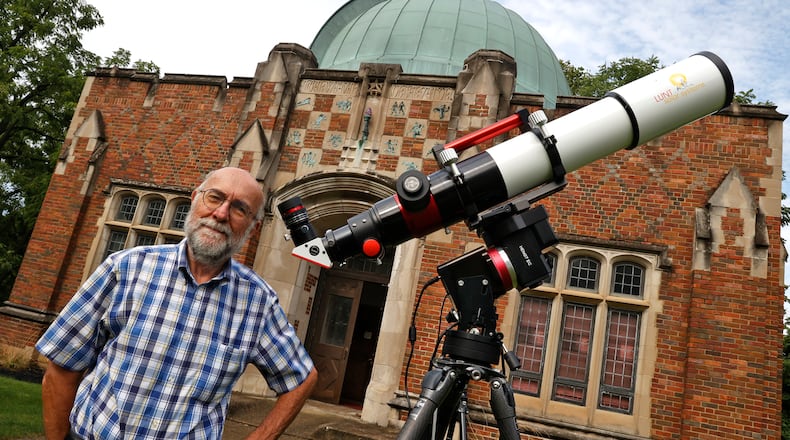But tension is nearing its peak in that burning ball of plasma just eight light minutes away.
And for those interested in a safe peek at the action, this is a good week.
From 10 a.m. to 2 p.m. every clear day, Monday through Friday, Dan Fleisch, professor emeritus of physics at Wittenberg University, will have his “super-duper” telescope set up in front of Wittenberg’s Weaver Observatory.
It’s same instrument sky watchers from all over the world this month when Fleisch had a special return engagement as astronomer in residence at the Grand Canyon. He was there at the invitation of the National Parks Service and the Grand Canyon Conservancy.
What’s special about the telescope, he explained, is that it filters out all of the visible spectrum but “a sliver of red light given off by hydrogen atoms,” atoms that enjoy a supermajority on the sun.
The filter eliminates the sun’s glare and allows the viewer to see sunspots, flares and protuberances that are the superstorms of solar weather.
Astronomers also look out areas called plages, associated with the French word for beaches, though sunning yourself on them is contraindicated.
The “beaches” are of interest, Fleisch said, because they indicate hot areas that are precursors of spots.
The uptick in the activity of solar weather is the result of the behavior of the plasma the sun and are stars are made of.
We earthlings tend to know more about the states of matter known as solids, liquids and gasses. Plasma -- called “the fourth state of matter” – is the electrically charged gas that constitutes 99 percent of the visible universe.
Fleisch takes it from there.
“The sun rotates, just like the earth,” he said. “It takes about month.”
“But it’s complicated,” he explains, because “the sun’s equator turns faster than the poles.” The rotation that takes 25 days at the equator takes 35 days at the pole.
Over 11 years, the differential leads to the development of bulges, kinks and twists in the plasma that Fleisch compares the bulges, kinks and twists of a rubber band on an overly wound up toy airplane.
When the tension cranks up, they “produce flares and suns,” he said, which increase in frequency until the point at which sun’s magnetic field reverses, releasing the tension and restoring a relative state of calm.
Fleisch said the drama now playing out was reflected on the faces of the people watching it through a wireless projection from his telescope at the edge of the Grand Canyon.
He not only saw a jaw drop but heard speakers of Italian cry out “Mamma Mia,” just like they do in the Godfather movies and the Abba musical.
Fleisch had his own Mamma Mia moment when his super-duper telescope provided him a physics first after more than 70 years on the planet: The chance to look at our solar system’s stellar object and see something move.
In the past, that movement could not be seen by even his trained naked eye but observed only in a sequence of photos taken at different moments. The distances involved coupled with the size of what was being observed were just too great.
The moment he detected the expanding sun flare, he turned his head to call his physics friends to the telescope. Looking back while they were heading toward him, he glanced again through the eyepiece and continued to watch the flare expand suddenly into “multiple earths in diameter.”
What he’d seen was an X-Class solar flare that was having down-to-earth consequences .
“An hour later,” he said, “there were reports of radio blackouts in the Western U.S.” and of interference with signals from satellites that provide signals for Global :Positioning Systems like the ones that inform our cell phones.
As exciting as all this is, in the run-up to April 8 full solar eclipse that will be visible in Ohio, weather permitting, Fleisch is sending out his own message: Don’t look directly at the sun with the naked eye, through exposed film or even through welder’s glass, which has the risk of being chipped or broken.
If you’re tempted to, you’re advised to binge watch “The Christmas Story” instead and heed its most often quoted phrase: You’ll put your eye out, kid.
About the Author
